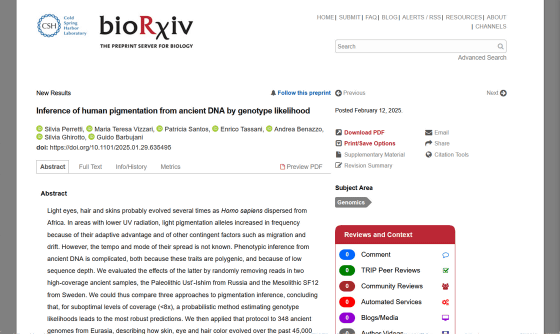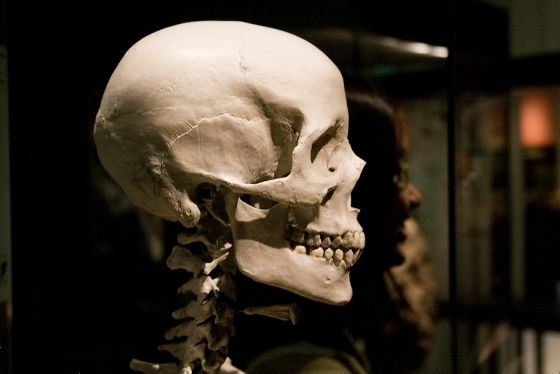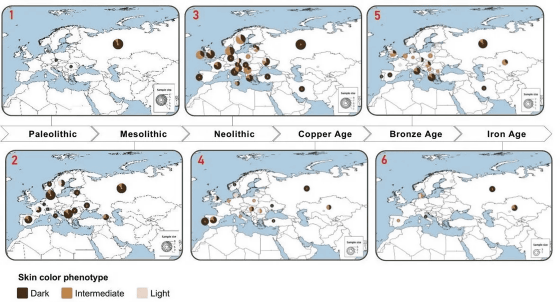Up until about 3,000 years ago, many Europeans may have had dark skin, hair, and eyes.

Modern people's skin, hair, and eye colors vary by race, but generally, people of European descent tend to have lighter skin, lighter hair colors such as blonde, red, and brown, as well as black, and a wide variety of eye colors such as blue, brown, green, and gray. However, a new study analyzing the DNA of ancient people has shown that up until about 3,000 years ago, most Europeans may have had dark skin, hair, and eyes.
Inference of human pigmentation from ancient DNA by genotype likelihood | bioRxiv

Most ancient Europeans had dark skin, eyes and hair up until 3,000 years ago, new research finds | Live Science
https://www.livescience.com/archaeology/most-ancient-europeans-had-dark-skin-eyes-and-hair-up-until-3-000-years-ago-new-research-finds
Modern humans , Homo sapiens , are a species that originated in Africa and originally had black skin and hair. As they gradually migrated around the world, it is thought that the frequency of genes with lighter pigmentation increased in individuals living in high latitudes with less ultraviolet light, either as an adaptive advantage or by chance.
Of course, early Homo sapiens who had just migrated from Africa to Europe would have had dark skin and hair like their African counterparts, but it's unclear when European Homo sapiens began to have the light skin, hair, and eye color seen in modern Europeans.
Therefore, a research team led by Silvia Gillott , a geneticist at the University of Ferrara in Italy, analyzed the DNA of ancient Homo sapiens collected from ruins in 34 countries spanning Western Europe and Asia to investigate 'how light skin, hair, and eye color evolved. The paper was published on bioRxiv, a biology-related preprint server, and has not been peer-reviewed at the time of writing.

by
The oldest individual analyzed was 45,000 years old , discovered near the Irtysh River in Western Siberia in 2008. However, many of the old DNA samples were badly deteriorated, so the research team used 'probabilistic phenotype inference' to estimate the likelihood of genotypes, and the HIrisPlex-S system , which predicts skin, hair and eye color from incomplete DNA samples, to estimate the individual's pigmentation.
The analysis found that modern European-like traits first appeared in European Homo sapiens around 14,000 years ago, and that traits like light skin and light hair only appeared sporadically after that, eventually becoming widespread around 3,000 years ago.
This means that until surprisingly and quite recently, dark skin, dark hair and dark eyes were predominant among people living in Europe.
The figure below shows the proportion of skin color that Homo sapiens had at that time, in the order of '1: Paleolithic (Old Stone Age: about 45,000 to 13,000 years ago)', '2: Mesolithic (Middle Stone Age: about 14,000 to 4,000 years ago)', '3: Neolithic (New Stone Age: about 10,000 to 4,000 years ago)', '4: Copper Age (Copper Age: about 6,000 to 3,500 years ago)', '5: Bronze Age (Bronze Age: about 7,000 to 3,000 years ago)', and '6: Iron Age (Iron Age: about 3,000 to 1,700 years ago)'. From the Paleolithic to the Mesolithic era, black skin (Dark) was overwhelmingly dominant, and from around the Neolithic era, brown (Intermediate) and light skin (Light) gradually increased. Even in the Bronze Age, brown skin prevailed across much of Europe, with black skin prevailing in the Iberian Peninsula, Italy and Central Europe.

Carles Larueza Fox of the Institute of Evolutionary Biology in Barcelona, Spain, who was not involved in the study, told Live Science in an email that it was surprising that Europeans inherited genes for dark pigmentation until relatively recently, but added that it's still not well understood why light skin, hair, and eye color might have conferred an evolutionary advantage.
Related Posts:
in Science, Posted by log1h_ik







